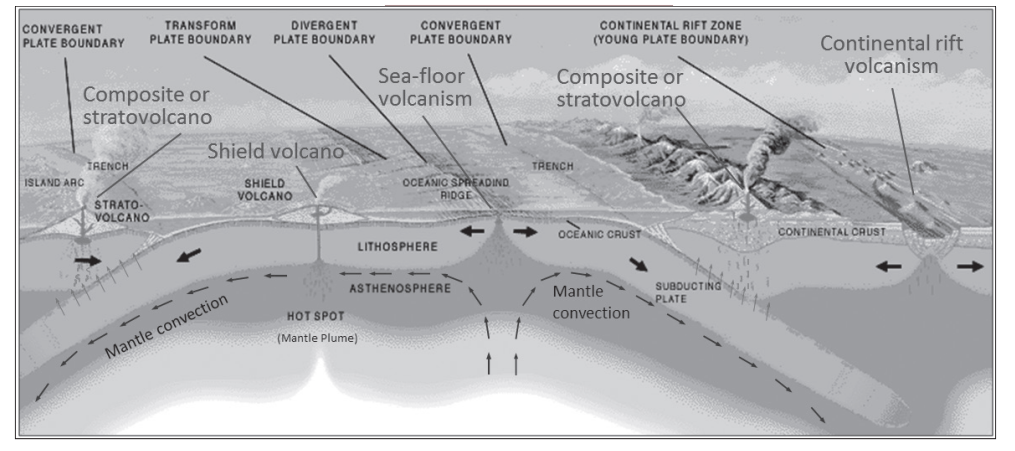-
12 Nov 2021
GS Paper 1
Geography
Q. What are the different types of plate tectonic boundaries? Also mention various types of landforms associated with each type of plate boundary. (250 words)
- Give a brief introduction to plate tectonic boundaries
- Discuss their types
- Mention various types of landforms associated with each type
Answer
- A tectonic plate (also called lithospheric plate) is a massive, irregularly-shaped slab of solid rock, generally composed of both continental and oceanic lithosphere. Plates move horizontally over the asthenosphere as rigid units. These plates have been constantly moving over the globe throughout the history of the earth. A plate may be referred to as the continental plate or oceanic plate depending on which of the two occupy a larger portion of the plate.
The different types of plate tectonic boundaries are
- Divergent boundary: A divergent boundary occurs when two tectonic plates move away from each other. Along these boundaries, earthquakes are common and magma (molten rock) rises from the Earth’s mantle to the surface, solidifying to create a new oceanic crust. For example: Mid-Atlantic Ridge.
- Convergent boundary: When two plates come together, it is known as a convergent boundary. The impact of the colliding plates can cause the edges of one or both plates to buckle up into mountain ranges or one of the plates may bend down into a deep seafloor trench. A chain of volcanoes often form parallel to convergent plate boundaries and powerful earthquakes are common along these boundaries. For example: the Washington-Oregon coastline.
- Transform plate boundary: Two plates sliding past each other forms a transform plate boundary. Natural or human-made structures that cross a transform boundary are offset—split into pieces and carried in opposite directions. Rocks that line the boundary are pulverized as the plates grind along, creating a linear fault valley or undersea canyon. Earthquakes are common along these faults. In contrast to convergent and divergent boundaries, the crust is cracked and broken at transform margins but is not created or destroyed. For example-San Andreas Fault Zone.

The various types of landforms associated with each type of plate boundary are
- Fold Mountains: The compress forces stemming from a convergent plate boundary, where two plates collide with one another, can create fold mountains. Mountains 100 million years old or less, such as the Himalayas, are known as young fold mountains and account for the planet’s highest, most impressive ranges. Old fold mountains, which typically formed 250 million years ago or more, mark formerly active plate boundaries and tend to be significantly lower and more eroded; examples include the Appalachians and Urals.
- Ocean Trenches: Ocean trenches form at two kinds of convergent plate boundaries: where a continental and oceanic plate converge, or where two oceanic plates converge. The deepest ocean trench is the Mariana Trench.
- Ocean Ridges: At divergent boundaries, plates move away from each other, creating a new crust as magma is pushed up from the mantle. Mid-ocean ridges result from volcanic swelling and eruptions along the divergent boundary. The movement of the tectonic plates transports the newly formed crust away from the crest of the ridge in both directions. Mid-Atlantic Ridge serves as a well-known example.
- Island Arcs: Subduction process that occurs when an oceanic plate converges with another oceanic plate, that can lead to volcanoes being formed paralleling the trench. A curved chain of these volcanoes, known as an island arc, usually occurs in these cases.




